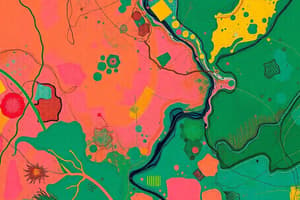Podcast
Questions and Answers
_______ is considered as fine grained soil.
_______ is considered as fine grained soil.
Silt
Fine sand has particles that are more angular than the ______ and fine sand particles.
Fine sand has particles that are more angular than the ______ and fine sand particles.
coarse
Clay is plate like, scale like, or rod like in shape as a result from ______ weathering.
Clay is plate like, scale like, or rod like in shape as a result from ______ weathering.
chemical
Gravel consists of rock fragments more or less rounded by water action or ______.
Gravel consists of rock fragments more or less rounded by water action or ______.
Silt grain is similar to fine sand with the same ______ composition.
Silt grain is similar to fine sand with the same ______ composition.
Colloidal clay is a type of ______ that exhibits unique behavior due to its small particle size.
Colloidal clay is a type of ______ that exhibits unique behavior due to its small particle size.
Silt Size – 0.05 to 0.002 mm falls under the category of ______ soils.
Silt Size – 0.05 to 0.002 mm falls under the category of ______ soils.
Unified Soil Classification System categorizes soils into Coarse Grained and ______ Grained Soils.
Unified Soil Classification System categorizes soils into Coarse Grained and ______ Grained Soils.
Group Symbols for Fine Grained Soil include ML, CL, and ______.
Group Symbols for Fine Grained Soil include ML, CL, and ______.
The diagonal line drawn in the plasticity chart is called the “A” Line and is given by the equation, PI = 0.73 (LL-______).
The diagonal line drawn in the plasticity chart is called the “A” Line and is given by the equation, PI = 0.73 (LL-______).
AASHTO Soil Classification system considers the ______ index for classification.
AASHTO Soil Classification system considers the ______ index for classification.
The second term in the AASHTO Soil Classification is the partial group index determined from the ______ index.
The second term in the AASHTO Soil Classification is the partial group index determined from the ______ index.
Colloidal Clay is a finer clay particle that remains suspended in water and do not settle under the force of gravity. It is a type of ______.
Colloidal Clay is a finer clay particle that remains suspended in water and do not settle under the force of gravity. It is a type of ______.
Rounded particles extracted from streams which have undergone wear are considered strong materials. Flat and flaky particles are weak and variable, which may not be suitable for various uses. Angular or roughly cubical shaped particles produced from crushing increase the resistance of soil mass to deformation due to ______ grains.
Rounded particles extracted from streams which have undergone wear are considered strong materials. Flat and flaky particles are weak and variable, which may not be suitable for various uses. Angular or roughly cubical shaped particles produced from crushing increase the resistance of soil mass to deformation due to ______ grains.
Rounded particles have the tendency to roll over when subjected to load. This characteristic is observed in ______ particles.
Rounded particles have the tendency to roll over when subjected to load. This characteristic is observed in ______ particles.
Fine Grained Soils are classified based on the percentage passing the No. 200 sieve. They include inorganic silt, inorganic clay, organic silt and clay, as well as peat, muck, and other highly organic soils. The symbol 'C' represents ______.
Fine Grained Soils are classified based on the percentage passing the No. 200 sieve. They include inorganic silt, inorganic clay, organic silt and clay, as well as peat, muck, and other highly organic soils. The symbol 'C' represents ______.
Pedology is the science of soils and is the basis for pedological classification. It follows the principle that 'like soils are developed on like slope when like materials are weathered in like fashion.' In the USDA Textural Classification System, 'L' represents fine grained soil with liquid limit less than 50 and low to medium compressibility. 'H' represents fine grained soil with liquid limit greater than 50 and high ______.
Pedology is the science of soils and is the basis for pedological classification. It follows the principle that 'like soils are developed on like slope when like materials are weathered in like fashion.' In the USDA Textural Classification System, 'L' represents fine grained soil with liquid limit less than 50 and low to medium compressibility. 'H' represents fine grained soil with liquid limit greater than 50 and high ______.
Sand Size ranges from 2.0 to 0.05 mm. It falls under the USDA Textural Classification System as ______ material.
Sand Size ranges from 2.0 to 0.05 mm. It falls under the USDA Textural Classification System as ______ material.
Flashcards are hidden until you start studying




